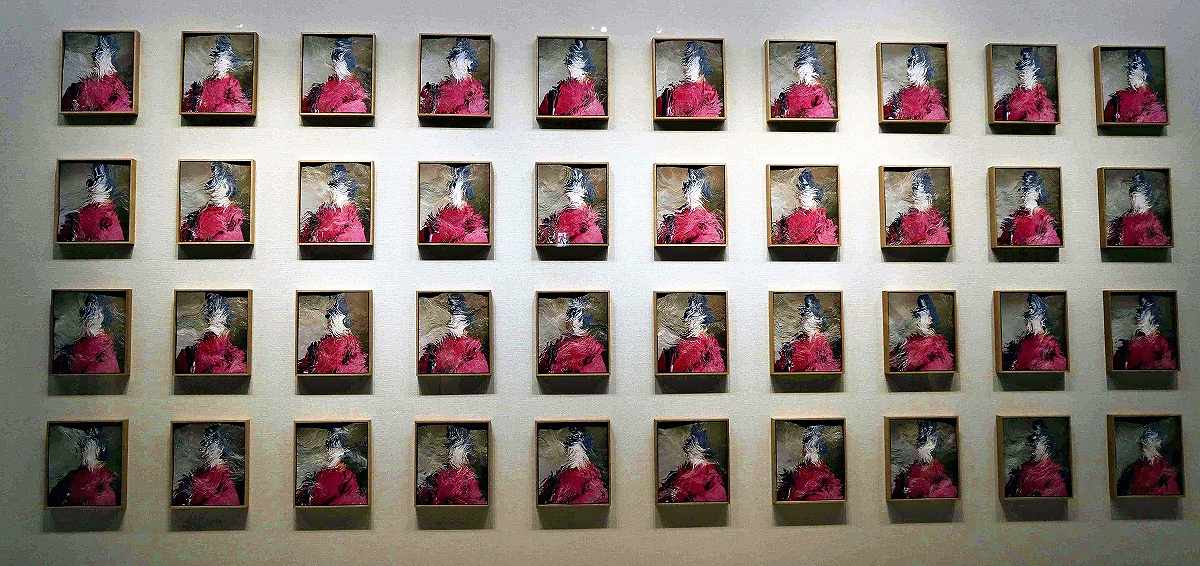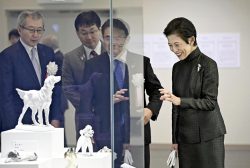
An art exhibition titled “Tenjin” with 40 “sculptured portraits”
15:00 JST, October 8, 2024
DAZAIFU, Fukuoka — More than 10 million people a year make the trip to Dazaifu Tenmangu, a shrine in Dazaifu, Fukuoka Prefecture, that offers visitors the opportunity to encounter contemporary art, which is found ubiquitously on its grounds.
Sugawara Michizane, the deity of learning, is enshrined here. Michizane is also believed to be the deity of culture and arts for his preeminence in waka, a type of 31-syllable Japanese poem, and calligraphy.
For more than 1,100 years, contemporary artists have dedicated their works to this sanctuary.
Crossing the red-colored arched taiko bashi bridge to enter the grounds of the shrine, visitors will find the homotsuden shrine museum behind a hand-purifying fountain.
This was the first facility registered as a museum in the prefecture, and it houses many cultural materials, including paintings and national treasures dedicated to the shrine.
This museum is also a cultural center for displaying contemporary art.
An exhibition of works by “Nerhol,” an artist duo comprising sculptor Ryuta Iida, 42, and graphic designer Yoshihisa Tanaka, 44, was held at the museum until Aug. 4.
Their work, titled “Tenjin,” was a collection of 40 portraits of a man dressed in a traditional costume. That man is Nobuhiro Nishitakatsuji, 44, the 40th chief priest of the shrine.
The duo first took 100 photos of the chief priest consecutively over several minutes. They prepared 40 sets of photos and repeated that process 40 times. Next, they used cutters and chisels to carve each set of photos. By carving in different ways, each set looks like a different figure.
The exhibition was part of the shrine’s art programs, which have been going on since 2006. Many contemporary artists, both from Japan and abroad, have been invited to produce works as part of the program.
The duo based their work on the theme of Tenmangu’s long history and surrounding nature, as well as the memories of people connected to the shrine.
Iida said, “Tenmangu is a mysterious place where time flows differently to the outside world.”
Everyone has their own history accumulated from the moments that make up their past and present, and the artwork represents that concept.
Iida said, “While carving, I was conscious of my effort to make the invisible visible.”
Rooftop forest
The combination of shrine and art may seem surprising, but Nishitakatsuji said, “A shrine where people gather and create culture while maintaining tradition goes well with art, which develops ideas based on concepts like history and time, often involving lots of people.”
A certified museum curator himself, Nishitakatsuji has led various cultural activities, including art programs.
He discovered the appeal of contemporary art, whose exhibitions include dialogues with the artist about their art, while studying art history at the University of Tokyo.
Shortly after he returned to Japan from his studies at Harvard University in the United States, he proposed a redesign of Homangu’s Kamado Shrine, where amulets will be conferred when it is rebuilt near Dazaifu Tenmangu. He commissioned interior designer Masamichi Katayama for the redesign.
The new shrine, which will be a gentle, cherry blossom-inspired color and built as a ring-shaped structure based on an image of a kamado, a wood-burning stove, is on everyone’s lips right now.
As visitors walk through the romon gate of Tenmangu, a mysterious structure comes into sight, with trees growing thickly atop its roof.

The temporary hall of Dazaifu Tenmangu, whose roof looks like a forest floating in midair
It’s a temporary hall installed in front of the honden, the main sanctuary of the shrine complex and is currently undergoing a major renovation until 2026.
Growing on its roof are camphor trees, cherry trees and plum trees, giving the impression of a forest floating in midair.
Nishitakatsuji asked Sosuke Fujimoto, a venue design producer working on next year’s Osaka-Kansai Expo, to design it.
The image of a “floating forest” came from an idea related to an anecdote about a sacred tree called the “tobiume” (flying plum). In the anecdote, a plum tree Michizane cherished in Kyoto flew overnight to Dazaifu to be reunited with him, as he had been exiled from Kyoto.
The plants on the roof will be transplanted to the shrine’s grounds when the temporary structure is demolished.
Standing on a hill next to Tenmangu is the Kyushu National Museum, which opened in 2005.
Going back to the Meiji era (1868-1912), Nishitakatsuji’s great-great-grandfather started the tradition of hosting a museum at Dazaifu. His descendants have been making similar efforts for generations.
Nishitakatsuji said: “How can we add new value to the shrine for the next millennium? That will be a gift to the future, I believe. I guess I’m part of the same lineage as my ancestors,” he said.
"Culture" POPULAR ARTICLE
-

Van Cleef & Arpels Dazzles with Art Deco Artisanry at Tokyo Exhibit
-

Disney’s ‘Twisted-Wonderland’ Animated Series Puts Villains in Spotlight: New Show Features School Inspired by Classic Disney Films
-

Japan Plans to Distribute Manga Overseas Via New Platform
-

Ayumi Hamasaki’s Shanghai Concert Canceled Day Before Schedule as Part of Beijing Backlash
-

‘The World Masterpiece Theater Series’ Celebrates 50 Years; Animator Looks Back on Creating Anime Classics
JN ACCESS RANKING
-

Keidanren Chairman Yoshinobu Tsutsui Visits Kashiwazaki-Kariwa Nuclear Power Plant; Inspects New Emergency Safety System
-

Imports of Rare Earths from China Facing Delays, May Be Caused by Deterioration of Japan-China Relations
-

University of Tokyo Professor Discusses Japanese Economic Security in Interview Ahead of Forum
-

Tokyo Economic Security Forum to Hold Inaugural Meeting Amid Tense Global Environment
-

Japan Pulls out of Vietnam Nuclear Project, Complicating Hanoi’s Power Plans

























